Clipart tagged: ‘coral producers zoantharia’

Blue Minyad (Minyas Cyanea)
"The Blue Minyad is a type of a family in which the base of the body, in place of extending itself in…

Caryophyllia Cyathus (Lamarck)
"This genus has the summit hollowed out into a starlike cup. It inhabits the Mediterranean, and is common…
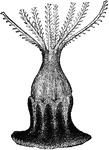
Coral Polyp (Lacaze-Duthiers)
"The polyp itself is formed of a whitish, membranous tube, nearly cylindrical, having an upper disk,…
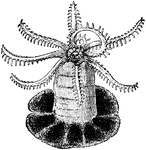
Coral Polyp (Lacaze-Duthiers)
"The arms of the polyps are at times subject to violent agitation, and the tentacula become much excited.…
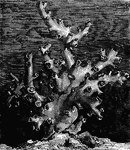
Dendrophyllia Ramea (De Blainville)
"The Madrepores abound in all inter-tropical seas, taking a considerable part in the formation of the…
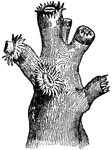
Dendrophyllia Ramea with Polypi (De Blainville)
"The Madrepores abound in all inter-tropical seas, taking a considerable part in the formation of the…
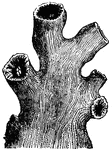
Dendrophyllia Ramea, Magnified (De Blainville)
"The Madrepores abound in all inter-tropical seas, taking a considerable part in the formation of the…
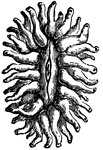
Flabellum Pavonium (Lesson)
"In the subfamily of the Zoanthidae, the polyps occur in clusters, and are multiplied by buds, rising…

Isis Hippuris
"A species of Isis has numerous slender branches, furnished with cylindrical knows at intervals,…
Loose Winged Virgularia (Virgularia Mirabilis)
"These winged species of polypidom are somewhat scythe-shaped, well developed, and furnished with a…

Branch of Loose Winged Virgularia
"These winged species of polypidom are somewhat scythe-shaped, well developed, and furnished with a…

Madrepora Plantaginea (Lamarck)
"The Plantain Madrepore is an interesting species, the polyps presenting themselves in tufts, with slender…

Oculina Virginea (Lamarck)
Oculina ranges from Cape Hatteras, North Carolina through the Gulf of Mexico and Caribbean, though the…
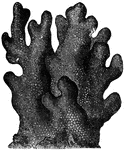
Porites Furcata (Lamarck)
"The polyp of the Porites is an animal somewhat pitcher-shaped, with twelve short tentacula,…

Magnified Portion of Fan Gorgon
"The Fan Gorgon, from the Antilles; it often attains a height of eighteen or twenty inches. The…
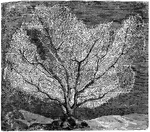
Gorgonia Flabellum
"The Fan Gorgon, from the Antilles; it often attains a height of eighteen or twenty inches. The…
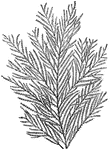
Gorgonia Verticellata
"The Fan Gorgon, from the Antilles; it often attains a height of eighteen or twenty inches. The…

Magnified Portion of Gorgonia Verticellata
"The Fan Gorgon, from the Antilles; it often attains a height of eighteen or twenty inches. The…

Pennatula Spinosa
"These winged species of polypidom are somewhat scythe-shaped, well developed, and furnished with a…

Tubipora Musica
"The Tubipora is a calcareous coral, formed by the combination of distinct, regularly arranged…

Crown of Delicately Fringed Tentacula of Tubipora Musica
"The Tubipora is a calcareous coral, formed by the combination of distinct, regularly arranged…
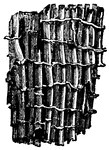
Magnified Portion of Tubipora Musica
"The Tubipora is a calcareous coral, formed by the combination of distinct, regularly arranged…

Polyp of Tubipora Musica
"The Tubipora is a calcareous coral, formed by the combination of distinct, regularly arranged…

Tube and Polyp of Tubipora Musica
"The Tubipora is a calcareous coral, formed by the combination of distinct, regularly arranged…
Umbellularia Groenlandica (Lamarck)
"The Umbellularia Groenlandica has a very long stem, which is terminated at the summit only…

Veretillum Cynomorium (Lamarck)
"The species shown in this figure has a simple, cylindrical body, without branchiae, and a rudimentary…